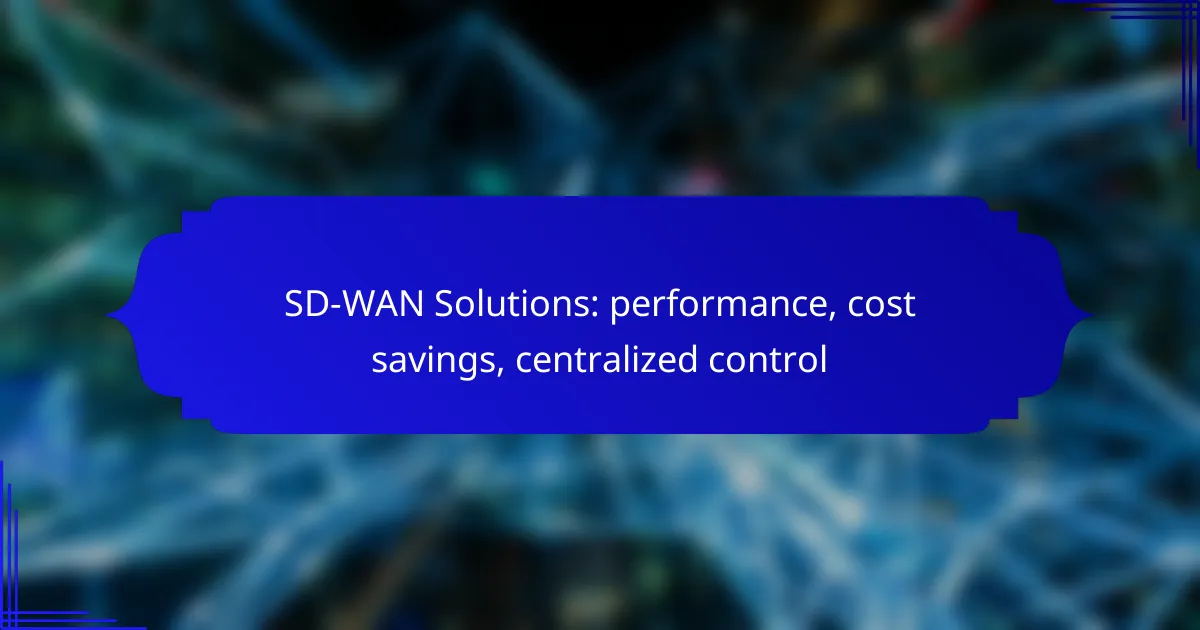SD-WAN solutions in New Zealand offer businesses a powerful way to enhance network performance, achieve cost savings, and maintain centralized control over their operations. By optimizing network traffic and ensuring reliable connectivity, these solutions adapt to varying conditions while significantly reducing IT expenses through efficient bandwidth usage and streamlined hardware requirements.

What are the SD-WAN solutions available in New Zealand?
In New Zealand, several SD-WAN solutions cater to businesses seeking improved network performance, cost savings, and centralized control. These solutions vary in features and capabilities, making it essential to evaluate each option based on specific organizational needs.
Cisco SD-WAN
Cisco SD-WAN is known for its robust security features and integration with existing Cisco infrastructure. It offers centralized management, allowing businesses to monitor and control their network from a single interface. This solution is ideal for organizations already using Cisco products, as it provides seamless integration and support.
Key considerations include its scalability and flexibility, which can accommodate growing network demands. Cisco SD-WAN typically operates on a subscription model, which can lead to predictable costs over time.
VMware SD-WAN
VMware SD-WAN focuses on optimizing application performance and enhancing user experience. It utilizes a cloud-delivered architecture that simplifies deployment and management. This solution is particularly beneficial for organizations with multiple locations, as it enables efficient traffic routing and load balancing.
When considering VMware SD-WAN, evaluate its ability to integrate with existing VMware environments. The pricing structure is generally competitive, making it an attractive option for businesses looking to reduce operational costs.
Silver Peak SD-WAN
Silver Peak SD-WAN emphasizes performance and reliability, particularly for cloud applications. It offers features like dynamic path control and WAN optimization, which help maintain high application performance even during network disruptions. This solution is well-suited for businesses that rely heavily on cloud services.
Organizations should consider the deployment complexity and the potential need for additional hardware. Silver Peak’s pricing can vary based on the features selected, so it’s advisable to assess the specific needs before committing.
Fortinet Secure SD-WAN
Fortinet Secure SD-WAN combines SD-WAN capabilities with advanced security features, making it a strong choice for businesses prioritizing security. It integrates firewall capabilities, intrusion prevention, and secure web gateways into a single solution. This dual focus on performance and security is beneficial for organizations handling sensitive data.
When evaluating Fortinet, consider its ease of integration with existing security infrastructure. The pricing model typically includes a subscription fee, which can be cost-effective for businesses looking to enhance their security posture.
Aruba SD-WAN
Aruba SD-WAN is designed for simplicity and ease of use, making it accessible for organizations without extensive IT resources. It provides centralized management and visibility, allowing businesses to manage their networks efficiently. This solution is particularly appealing for small to medium-sized enterprises seeking a straightforward deployment process.
Consider Aruba’s focus on user experience and application performance when making a decision. The pricing is competitive, often structured around a subscription model, which can help businesses manage their budgets effectively.

How do SD-WAN solutions improve performance?
SD-WAN solutions enhance performance by optimizing network traffic and ensuring reliable connectivity across multiple locations. They achieve this through advanced technologies that prioritize application performance and adapt to changing network conditions.
Dynamic path selection
Dynamic path selection allows SD-WAN solutions to intelligently route traffic over the most efficient paths based on real-time network conditions. This means that if one path experiences congestion or failure, the system can automatically switch to a more reliable alternative, ensuring minimal disruption.
For example, an SD-WAN might use multiple internet connections, such as MPLS and broadband, to balance traffic loads. This flexibility can lead to improved application performance and reduced downtime.
Application-aware routing
Application-aware routing enables SD-WAN to recognize and prioritize specific applications based on their performance requirements. By analyzing traffic patterns, the system can allocate bandwidth dynamically, ensuring critical applications receive the necessary resources for optimal performance.
For instance, video conferencing applications may be prioritized over less time-sensitive data transfers. This targeted approach helps maintain high-quality user experiences, especially during peak usage times.
Reduced latency
SD-WAN solutions can significantly reduce latency by optimizing data paths and minimizing the distance data must travel. By leveraging local internet connections and strategically placed data centers, SD-WAN can deliver faster response times for users.
In practice, this means that remote offices can access cloud applications with lower delays, enhancing productivity. Users may experience latency improvements in the range of tens of milliseconds, which is critical for real-time applications like VoIP and video streaming.

What cost savings can SD-WAN provide?
SD-WAN solutions can deliver significant cost savings by optimizing bandwidth usage, reducing hardware needs, and enhancing operational efficiency. These savings can lead to lower overall IT expenses and improved budget allocation for businesses.
Lower bandwidth costs
SD-WAN can reduce bandwidth costs by enabling organizations to utilize lower-cost internet connections, such as broadband or LTE, instead of expensive MPLS links. By intelligently routing traffic based on real-time performance metrics, businesses can maximize their existing bandwidth and minimize unnecessary expenditures.
For example, companies can achieve savings of up to 50% on their monthly bandwidth bills by transitioning to a hybrid model that combines various types of connections. This flexibility allows for better resource allocation and cost management.
Reduced hardware expenses
Implementing SD-WAN can lead to reduced hardware expenses by consolidating network functions into a single device. Traditional WAN setups often require multiple hardware components, which can be costly and complex to manage. With SD-WAN, organizations can deploy virtualized services, reducing the need for physical appliances.
Additionally, many SD-WAN solutions offer cloud-based management, which eliminates the need for on-premises hardware, further driving down costs. This shift not only saves money but also simplifies network management and maintenance.
Operational efficiency
SD-WAN enhances operational efficiency by automating network management tasks and providing centralized control over the entire network. This allows IT teams to quickly respond to issues, optimize performance, and ensure consistent service delivery across all locations.
Moreover, the ability to easily scale the network as business needs change means organizations can avoid the costs associated with over-provisioning or under-utilizing resources. By streamlining operations, businesses can focus on strategic initiatives rather than day-to-day network management.

How does centralized control work in SD-WAN?
Centralized control in SD-WAN streamlines network management by allowing administrators to configure, monitor, and optimize the entire network from a single interface. This approach enhances visibility and simplifies the deployment of policies across multiple locations, ensuring consistent performance and security.
Single-pane management
Single-pane management refers to the ability to oversee all network components from one dashboard. This unified view allows IT teams to quickly access information about network performance, application usage, and security status without switching between different tools. It reduces complexity and speeds up troubleshooting, enabling faster response times to issues.
Policy-based automation
Policy-based automation enables organizations to define rules that automatically adjust network behavior based on specific conditions. For instance, if an application experiences latency, the system can reroute traffic to a more optimal path without manual intervention. This proactive approach not only enhances performance but also minimizes downtime and improves user experience.
Real-time monitoring
Real-time monitoring provides continuous visibility into network performance and health. Administrators can track metrics such as bandwidth usage, latency, and packet loss, allowing for immediate identification of potential issues. Many SD-WAN solutions offer alerts and analytics, helping teams to make informed decisions and optimize resources effectively.

What are the prerequisites for implementing SD-WAN?
Implementing SD-WAN requires a solid understanding of your current network infrastructure, bandwidth needs, and application performance requirements. Organizations must assess their existing WAN setup and determine the necessary hardware and software components to support SD-WAN deployment.
Network Assessment
A thorough network assessment is crucial before implementing SD-WAN. This involves analyzing current bandwidth usage, latency, and application performance across various locations. Understanding these metrics helps identify bottlenecks and informs the design of the new SD-WAN architecture.
Consider using network monitoring tools to gather data on traffic patterns and application performance. This information will guide decisions on bandwidth allocation and the selection of SD-WAN providers that best meet your needs.
Hardware and Software Requirements
To implement SD-WAN, organizations need compatible hardware, such as routers or appliances that support SD-WAN functionalities. Additionally, ensure that your existing network infrastructure can integrate with the chosen SD-WAN solution.
Software requirements include a management platform for centralized control and monitoring. Many SD-WAN solutions offer cloud-based management, which simplifies deployment and ongoing management.
Security Considerations
Security is a critical aspect of SD-WAN implementation. Organizations should evaluate their security policies and ensure that the chosen SD-WAN solution includes built-in security features such as encryption, firewalls, and intrusion detection systems.
It’s advisable to conduct a risk assessment to identify potential vulnerabilities in the new SD-WAN setup. This proactive approach helps in selecting a solution that aligns with regulatory requirements and industry best practices.
Vendor Selection
Choosing the right SD-WAN vendor is essential for successful implementation. Evaluate vendors based on their technology, support services, and pricing models. Look for providers that offer flexibility in deployment options, whether on-premises, cloud-based, or hybrid.
Consider conducting proof-of-concept trials with shortlisted vendors to assess their solutions in real-world scenarios. This hands-on experience can provide valuable insights into performance and ease of use.
